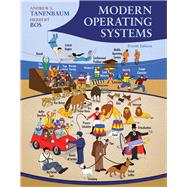Modern Operating Systems, Fourth Edition, is intended for introductory courses in Operating Systems in Computer Science, Computer Engineering, and Electrical Engineering programs. It also serves as a useful reference for OS professionals
¿
The widely anticipated revision of this worldwide best-seller incorporates the latest developments in operating systems (OS) technologies. The Fourth Edition includes up-to-date materials on relevant¿OS. Tanenbaum also provides information on current research based on his experience as an operating systems researcher.
¿
Modern Operating Systems, Third Editionwas the recipient of the 2010 McGuffey Longevity Award. The McGuffey Longevity Award recognizes textbooks whose excellence has been demonstrated over time.¿http://taaonline.net/index.html
¿¿
Teaching and Learning Experience
This program will provide a better teaching and learning experience–for you and your students. It will help:
¿
- Provide Practical Detail on the Big Picture Concepts: A clear and entertaining writing style outlines the concepts every OS designer needs to master.
- Keep Your Course Current: This edition includes information on the latest OS technologies and developments
- Enhance Learning with Student and Instructor Resources: Students will gain hands-on experience using the simulation exercises and lab experiments.








